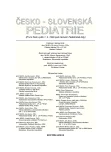Inborn Heart Defects and Their Risk Factors
Authors:
J. Pavlíček; T. Gruszka
Authors‘ workplace:
Dětské oddělení, Městská nemocnice Ostrava-Fifejdy
primář MUDr. T. Gruszka
; Ambulance dětské a prenatální kardiologie
Published in:
Čes-slov Pediat 2010; 65 (11): 626-633.
Category:
Original Papers
Overview
Objective:
Evaluation of incidence of inborn heart defects (IHD) in the Morava-Silesia Region and their relation to possible risk factors and extracardial diseases.
Methods:
A 10-year study following the incidence of inborn heart defects in the defined region combining prenatal screening and postnatal examination.
Results:
In the observed period (1999–2008) there was a total of 402 (3.65/100,000 births) prenatally recognized and/or postnatally significant IHD. Prenatal detection concerned 174 IHD (43.3%), whereas 228 (56.7%) were not prenatally recognized. At the authors’ workplace 20,471 women were examination during prenatal screening and 142 IHDs were detected. A risk factor in anamnesis occurred in 3095 pregnancies (15.1%) with 33 resulting IHDs. The paper analyzes in detail individual groups of risk factors and results of the examinations. In the group of genetic observation, 782 fetuses were enrolled and extracardial defects were detected in 608 fetuses (78%), isolated heart defects were present in 120 cases (15%), and combined extracardial diseases and IHD in 54 fetuses (7%). Chromosomal aberrations in IHD were diagnosed in 13.2% of cases.
Conclusions:
The statistical evaluation of the results of pregnancy failed to determine any relationship between the IHD occurrence and the age of the mother, other risk factors were generally significant. Etiology of IHD is mostly multifactorial, the defects occur mostly isolated and for their prenatal detection a general planned screening appears to be most productive. The fetus in a mother with risk anamnesis should always be examined.
Key words:
inborn heart defect, screening, fetal echocardiography, risk factor
Sources
1. Pavlíček J, Gruszka T. Výskyt vrozených srdečních vad a jejich prenatální detekce v Moravskoslezském kraji. Čes.-slov. Pediat. 2007; 62(4): 196–203.
2. Smrcek JM, Berg Ch, Geipel A, et al. Early fetal echocardiography. J. Ultrasound Med. 2006; 25: 173–182.
3. Smrcek JM, Berg Ch, Geipel A, et al. Detection rate of early fetal echocardiography and in utero development of congenital heart defects. J. Ultrasound Med. 2006; 25: 187–196.
4. Homola J, Satrapa V. Transvaginální echokardiografie v časné diagnostice vrozených srdečních vad plodu. Čes.-slov. Pediat. 1993; 48(12): 711–713.
5. Marek J. Pediatrická a prenatální echokardiografie. Praha: Triton, 2003: 51–77.
6. Škovránek J, Marek J, Povýšilová V. Prenatální kardiologie. Čes.-slov. Pediat. 1997; 52(6): 332–338.
7. Homola J, Karamanov S, Satrapa V, et al. Chromozomální aberace u plodů s prenatálně diagnostikovanou vrozenou srdeční vadou. Čes.-slov. Pediat. 2003; 58(4): 183–186.
8. Chaloupecký V, et al. Dětská kardiologie. Praha: Galén, 2006: 67–69.
9. Hoffman JIE, Kaplan S. The incidence of congenital heart disease. J. Am. Coll. Cardiol. 2002; 39: 1890–1900.
10. Stoll C, Alembik Y, Roth MP, et al. Risk factors in congenital heart disease. Eur. J. Epidemiol. 1989; 5(3): 382–391.
11. Kidd SA, Lancaster PA, McCredie RM. The incidence of congenital heart defects in the first year of life. J. Paediatr. Child Health 1993; 29(5): 344–349.
12. Šamánek M, Slavík Z, Zbořilová B, et al. Prevalence, treatment, and outcome of heart disease in live-born children: A prospective analysis od 91,823 live born children. Pediat. Cardiol. 1989; 10(4): 205–211.
13. Whittemore R, Wells JA, Castellsague X. A second-generation study of 427 probands with congenital heart defects and their 837 children. J. Am. Coll. Cardiol. 1994; 23:1459–1467.
14. Thangaroopan M, Wald RM, Silversides CK, et al. Incremental diagnostic yield of pediatric cardiac assessment after fetal echocardiography in the offspring of women with congenital heart disease: A prospective study. Pediatrics 2008; 121(3): 660–665.
15. Gill HK, Splitt M, Sharland GK, et al. Patterns of recurrence of congenital heart disease. J. Am. Coll. Cardiol. 2003; 42: 923–929.
16. Khoshnood B, De Vigan C, Vodovar V, et al. Trends in prenatal diagnosis, pregnancy termination, and perinatal mortality od newborns with congenital heart disease in France, 1983–2000: A population-based evaluation. Pediatrics 2005; 115(1): 95–101.
17. Gregor V, Šípek A, Horáček J. Prenatální diagnostika a její úspěšnost v České republice. Prakt. Lék. 2007; 88(4): 228–233.
18. Eronen M, Siren MK, Ekblad H, et al. Short- and long-term outcome of children with congenital complete heart block diagnosed in utero or as a newborn. Pediatrics 2000; 106(1): 86–91.
19. Costedoat-Chalumeau N, Amoura Z, Le Thi Hong D, et al. Question about dexamethasone use for the preventive of anti-SSA related congenital heart block. Ann. Rheum. Dis. 2003; 62(10): 1010–1012.
20. Yang CH, Chen JY, Lee SC, et al. Successful preventive treatment of congenital heart block during pregnancy in a women with systemic lupus erythematosus and anti-Sjogren´s syndrome A/RO antibody. J. Microbiol. Immunol. Infect. 2005; 38: 365–369.
21. Jaeggi ET, Fouron JD, Silverman ED, et al. Transplacental fetal treatment improves the outcome of prenatally diagnosed complete atrioventricular block without structural heart disease. Circulation 2004; 110: 1542–1548.
22. McElhinney DB, Tworetzky W, Lock JE. Current status of fetal cardiac intervention. Circulation 2010; 121: 1256–1263.
Labels
Neonatology Paediatrics General practitioner for children and adolescentsArticle was published in
Czech-Slovak Pediatrics

2010 Issue 11
Most read in this issue
- Henoch-Schönlein purpura – State-of-the-Art Diagnosis and Treatment
-
Hemolytic Uremic Syndrome (HUS) – One of the Most Common Causes of Acute Renal Failure in Childhood.
Complexity of the Pathophysiology and Novel Diagnostic and Therapeutic Options for Atypical Forms - Current Trends in the Treatment of Invagination in Childhood
- Imunoglukan P4H® in the Prevention of Recurrent Respiratory Infections in Childhood
